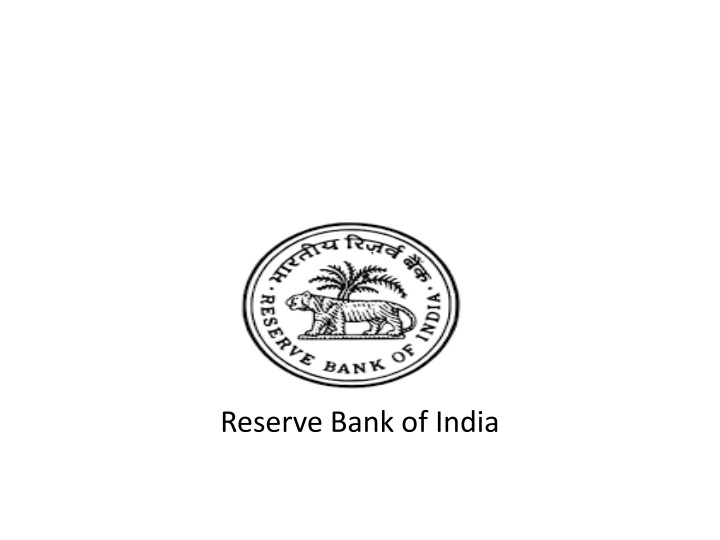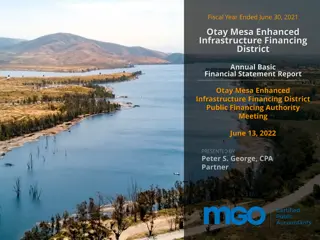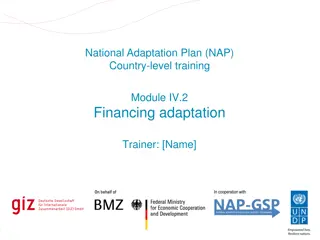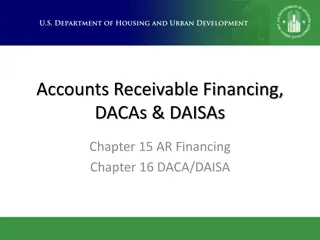
Insight into the Reserve Bank of India and NABARD
Discover the history and functions of the Reserve Bank of India (RBI), the central banking institution of India, established in 1935 under the RBI Act. Learn about its pivotal role in regulating commercial banks, controlling monetary policy, and fostering economic development. Also, explore the significance of NABARD, the apex development bank focused on rural development and prosperity in India.
Download Presentation

Please find below an Image/Link to download the presentation.
The content on the website is provided AS IS for your information and personal use only. It may not be sold, licensed, or shared on other websites without obtaining consent from the author. If you encounter any issues during the download, it is possible that the publisher has removed the file from their server.
You are allowed to download the files provided on this website for personal or commercial use, subject to the condition that they are used lawfully. All files are the property of their respective owners.
The content on the website is provided AS IS for your information and personal use only. It may not be sold, licensed, or shared on other websites without obtaining consent from the author.
E N D
Presentation Transcript
INTRODUCTION TO RBI Established in April 1935 under the RESERVE BANK OF INDIAN ACT 1934. Head Quarters MUMBAI The Reserve Bank of India is the central banking institution of India and controls the monetary policy of the rupee as well as currency reserves
History Of RBI It was set up on the recommendations of Hilton Young Commission It was started as share-holders bank with a paid up capital of 5 crores Initially it was located in Kolkata (Share holders Bank) It moved to Mumbai in 1937 Initially it was privately owned Since 1949, the RBI is fully owned by the Government of India. Its First governor was Sir Osborne A.Smith The First Indian Governor was Sir Chintaman D.Deshmukh Present Governor: ?
RBI plays an important part in the Development Strategy of the Government of India. RBI regulates commercial banks and non-banking finance companies working in India. It serves as the leader of the banking system and the money market. It regulates money supply and credit in the country Its anApex Bank
NABARD is an apex Development Bank authorised for providing and regulating credit and other facilities for the promotion and development industries, cottage and village industries, handicrafts and other rural crafts and other allied economic activities in rural areas with a view to promote integrated rural development and prosperity and for matters of agriculture, small-scale
NABARD was established on the recommendations of B.Sivaraman Committee, (by Act 61, 1981 of Parliament) on 12 July 1982 to implement the National Bank for Agriculture and Rural Development Act 1981 NABARD replaced the Agricultural Credit Department (ACD) and Rural Planning and Credit Cell (RPCC) of Reserve Bank of India, and Agricultural Refinance Corporation (ARDC). Mumbai is the headquarter of NABARD and Development
Objectives To give financial assistance for increasing the agriculture production To supply the long term needs of the rural areas To supply loans by way of refinance To help small industries, cottage industries and also artisans To achieve overall rural development
Functions of NABARD Credit Functions: Framing policy and guidelines for rural financial institutions. Providing credit facilities to issuing organizations Monitoring the flow of ground level rural credit. Preparation of credit plans annually for all districts for identification of credit potential
Development Functions: Help cooperative banks and Regional Rural Banks to prepare development actions plans for themselves. Help Regional Rural Banks and the sponsor banks to enter into MoUs with state governments and cooperative banks to improve the affairs of the Regional Rural Banks. Monitor implementation of development action plans of banks. Provide financial support for the training institutes of cooperative banks, commercial banks and Regional Rural Banks. Provide financial assistance to cooperative banks for building improved management information system, computerisation of operations and development of human resource
Development Functions: Help cooperative banks and Regional Rural Banks to prepare development actions plans for themselves. Help Regional Rural Banks and the sponsor banks to enter into MoUs with state governments and cooperative banks to improve the affairs of the Regional Rural Banks. Monitor implementation of development action plans of banks. Provide financial support for the training institutes of cooperative banks, commercial banks and Regional Rural Banks. Provide financial assistance to cooperative banks for building improved management information system, computerisation of operations and development of human resource
Supervisory Functions: Undertakes inspection of Regional Rural Banks (RRBs) and Cooperative Banks (other than urban/primary cooperative banks) under the provisions of Banking Regulation Act, 1949. Undertakes inspection of State Cooperative Agriculture and Rural Development Banks (SCARDBs) and apex non- credit cooperative societies on a voluntary basis. Provides recommendations to Reserve Bank of India on issue of licenses to Cooperative Banks, opening of new branches by State Cooperative Banks and Regional Rural Banks (RRBs). Undertakes portfolio inspections besides off-site surveillance of Cooperative Banks and Regional Rural Banks (RRB)
Regional Rural Banks Introduction RRBs are oriented towards meeting the needs of the weaker sections of the rural population consisting of small & marginal farmers, agricultural laborers, artisans & small entrepreneurs Historical Background RRBs were established under the provisions of an Ordinance passed on September 1975 and the RRBAct. 1976. It established to provide sufficient banking and credit facility for agriculture and other rural sectors during the tenure of Indira Gandhi's government with a view to include rural areas into economic mainstream.
The development process of RRBs started on 2 October 1975 with the forming of the first RRB, the Prathama Bank. Also on 2 October 1976 five regional rural banks were set up with a total authorised capital of Rs. 100 crore which later augmented to 500 crore
Sponsecers The Regional Rural Bank were owned by the Central Government, the State Government and the Sponsor Bank Shares in the ratios Central Government State Government ,Sponsor Banks 50% 35% 15% The Regional Rural Banks recommendations of Narsimham Committee on Rural Credit were established on the
Special features With a view to facilitate RRBs operation, the RBI gave RRBs direct access to refinance assistance at a concessional rate of 3% below the bank rate. Allowed to maintain a lower level of SLR than commercial bank. Allowed to pay half per cent more interest on all deposits except those of 3 years and above. Sponsor banks IDBI, NABARD, SRDBI, and other FIs are required under the RRBs act to provide managerial and financial assistance to RRBs
Objectives Taking the banking services to the doorstep of rural masses, particularly in hitherto unbanked rural areas. Making available institutional credit to the weaker sections of the society who had by far little or no access to cheaper loans and had perforce been depending on the private money lenders. Mobilize rural savings and channelize them for supporting productive activities in rural areas
To create a supplementary channel for the flow the central money market to the rural areas through refinances Generating employment opportunities in rural areas and bringing down the cost of providing credit to rural areas. With these objectives in mind, knowledge of the local language by the staff is an important qualification to make the bank accessible to the peopleRole of RRBs/Gramin Bank The role of RRBs can not be ignored present days. Banking as these Gramin Banks have played a major role in implementation of central and state govt. sponsored various programme of poverty alleviation like SGSRY, PMRGP, Old age pension, Payment to Anganwadi, Mid Day meal, Scholarship to students, IAY, Labour payment to NAREGAbeneficiary has effectively been carried by these RRBs






















